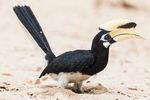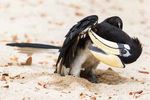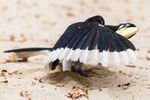A UK Chalk Down named Martin - Plight of the Asian Elephant Oriental Pied Hornbills Dust Bath Pinnipeds in New Zealand - Tim Plowden
←
→
Page content transcription
If your browser does not render page correctly, please read the page content below
Official Magazine of Nature Society (Singapore) Volume 27 No 2 Apr-Jun 2019 S$5.00
A UK Chalk Down
named Martin
Plight of the Asian Elephant
Oriental Pied Hornbills Dust Bath
Pinnipeds in New Zealand
MCI (P) 064/04/2019B i r d B E H A V i O U r
Hornbill Social Dust Bath
Human parenting and play meets bird parenting and play when Tim Plowden
takes his daughter to the park.
Text and photos by Tim Plowden
T
he Oriental Pied Hornbill Here they delight local children, where they gather for a communal dust
(Anthracoceros albirostris) including my 2-year-old daughter, with bath. Communal dust bathing has been
is now a familiar sight their vocal interaction and antics at the documented in arable fields with the
to many people living in playground, play chasing each other from Malabar Pied Hornbill (Ocyceros griseus)
Singapore. This familiarity tree to tree, hopping around branches to in rural India. In Singapore children now
presents us with the unique opportunity fence bills with each other, occasionally share their playground with a popular
to observe their fascinating social behav- pulling off twigs and bark, before local bird allowing these birds to dust
iour. This potential is enhanced by their descending to perch on swings, see saws bathe and preen relatively undisturbed.
increasing acceptance of our presence and park signboards where they indulge
in many places, such as Pasir Ris Park in more social object play. Social dusting
which is home to a flock of approxi- It was my daughter who drew my Dust baths, also called dusting or sand
mately 20 birds. attention to the flock’s visit to a sand pit bathing, are part of a bird’s preening
The feathers may be fluffed and the tail spread so the dust can reach the skin more easily.
20 Nature Watch Apr – Jun 2019and plumage maintenance that keeps
feathers in top condition. Dust bath-
ing appears to take place in the late
afternoon and the hornbills will return
to the same dusting spot at the main
playground which has space for the
entire flock to wallow and suitable sand
for dusting. Not all the flock will dust at
the same time; some wait nearby or are
preoccupied with social play. Dust bath-
ing is not always a communal affair for
the flock. Smaller family groups can be
found at smaller dust baths in the park.
Smaller dust baths are typically tempo-
To take a dust bath, a bird begins by scraping its feet in dry, fine, crumbly dirt or rary in nature – either areas of dusty soil
sand to create a wallow. created by dry weather or loose sand left
by maintenance work in the park.
Dust baths, also called dusting or sand bathing, are
Preening
part of a bird’s preening and plumage maintenance Preening typically follows immediately
that keeps feathers in top condition. after a dust bath as part of the hornbills’
grooming regime. While preening, the
The dust that is worked into the bird’s feathers will absorb Female hornbill works a piece of dry earth between her
excess oil to help keep the feathers from becoming greasy or mandibles while trying to crush it to dust.
matted.
Preening often follows immediately after a dust bath as the Stretching during preening helps provide space between
bird continues its grooming. each feather so the entire feather can be stroked and
groomed effectively.
Apr – Jun 2019 Nature Watch 21MAlE Or FEMAlE?
The casque and bill size and colour are the fastest and easiest way to
distinguish sex and age — and sometimes individuals. If you get close
enough, you will see the male (higher up on branch in image) has red eyes.
MAlE FEMAlE
đƫ! ƫ!5!/ đƫ.
5%/$ƫ
.+3*ƫ!5!/
đƫ
.#!.ƫ
%((ƫ
* ƫ
/-1!ċ đƫ)
((!.ƫ
%((ƫ
* ƫ
/-1!ċ
đƫ%((ƫ*!
.(5ƫ +),(!0!(5ƫ5!((+3ƫ đƫ +.!ƫ
(
'ƫ+*ƫ0$!ƫ
%((ƫ!/,! %
((5ƫ
except for black patch at base of at the tip of the upper bill and
lower bill. the patch on lower bill base.
đƫ
/-1!ƫ%/ƫ5!((+3ƫ3%0$ƫ
ƫ
(
'ƫ
patch sometimes resembling a
stripe starting about half way
along the bottom edge and
extending forwards towards
the tip of the casque. Area of In jUVEnilES the bill and casque
black on casque varies between are pale yellow (no black). The
individuals. casque is barely noticeable.
hornbills remove dirt and parasites from Social Play social play in birds is more likely to
their feathers and align each feather in Oriental Pied Hornbills display four occur when delayed reproduction is
the perfect position. It is not only a vital categories of social play: play chasing, accompanied by persisting relation-
maintenance activity, for adults it also play fighting, play invitations, and ships between adults and post-fledgling
helps them to communicate a healthier social object play. Why are hornbills juveniles. There are many benefits to
appearance to attract a stronger mate. more likely to play than many other different kinds of play: establishing
Some of the adult hornbills allopreen birds? One factor which enables play social rank, learning social rules, prac-
during the communal dust bath, which to evolve is larger brain size which is ticing survival skills, establishing motor
helps keep the connection between linked to the amount of time the adults coordination and social bonding.
mates strong. spend rearing the young. Complex
Personal observations
During the breeding season (January
to June), I typically see more males
than females in the foraging flocks.
From April, I start to see more females
foraging in the flock.
It is not a hard and fast rule,
but I typically see juveniles foraging
with parents and have not yet seen
juveniles in foraging flocks of adults or
subadults.
It is likely the large group of
hornbills I saw at the playground
belonged to a roosting flock which
were gathering at the start of the
breeding season to forage and interact.
Seeing 20 in one flock is
special as the most I typically see in
foraging flocks is 12. I could speculate
that the reason for this flock of 20
Social object play occurs when two or more individuals engage in repeated forming as being related to the onset
interaction with one or more inanimate objects in the environment without
subsequent consummatory behavior. The best evidence of social object play is of breeding season: some species use
provided by contests over items that cannot be otherwise turned to useful purposes. flocking behaviour as part of breeding
role reversals are common in social object play. courtship. Whether this social sand
22 Nature Watch Apr – Jun 2019Play fighting involves action patterns derived from antagonistic behaviour, but which are performed in ways that minimise
injurious consequences.
is easy to understand why children are
so captivated by these intelligent and
charismatic birds. If they can help chil-
dren to get excited about wildlife and
the natural world, then their return to
Singapore is a resounding success.
rEFErEncES
1.Mayntz, M. (2019, January). “How and Why
Birds Take Dust Baths.” The Spruce. Retrieved
from https://www.thespruce.com/how-and-why-
birds-take-dust-baths-386438
2.Mayntz, M. (2019, January). “Preening: How
and Why Birds Preen.” The Spruce. Retrieved
from https://www.thespruce.com/why-birds-
preen-386448
3, 4 Diamond, J., & Bond, A. (2003). “A
Comparative Analysis of Social Play in Birds.”
Behaviour, 140: 1091.
Play fighting includes only a limited portion of the aggressive repertoire of
the species. 5.. Lents, N.H. (2016). Not So Different: Finding
Human Nature in Animals. New York, NY:
Columbia University Press
bath could be considered as some form One thing which should be noted
of lek – a communal area where two is that the hornbills could become the Singapore-based photographer and
or more males of a species perform victims of their own success. Their filmmaker Tim Plowden focuses on
courtship displays – is something which popularity with some local birders is wildlife conservation issues in Southeast
could be opened for discussion. diminishing due to suggestions that the Asia. Tim is engaged by conservation
Hornbills sometimes visit our hornbills are responsible for the decline organisations and media outlets to raise
apartment (at one end of the park) in smaller birds at the park. However, awareness on conservation issues relating to
where we've had a pair nesting nearby. this hasn’t stopped some photographers a range of endangered species. He recently
Recently, we had two males visit from getting too close to a hornbill nest worked with BirdLife International in
us, which is quite unusual. Their in the park, such that National Parks Singapore to produce a video about the
relationship fascinates me. Why did Board had to put up a cordon. critically endangered Helmeted Hornbill.
these two decide to forage together The regular contributor to Wildlife
apart from the flock? Maybe the larger A Welcome return Photographic Magazine has delivered a
foraging flock disbanded temporarily Despite seeing them regularly, hornbills series of visual stories about photographing
so that smaller groups could travel to still fascinate me with their playful social wildlife behaviour.
different areas of their territory. behaviour and strong family bond. It
Apr – Jun 2019 Nature Watch 23You can also read



























































